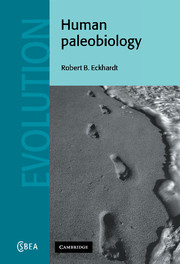Book contents
- Frontmatter
- Contents
- Preface
- Acknowledgments
- 1 Paleobiology: present perspectives on the past
- 2 Constancy and change: taxonomic uncertainty in a probabilistic world
- 3 A century of fossils
- 4 About a century of theory
- 5 Human adaptability present and past
- 6 Primate patterns of diversity and adaptation
- 7 Hominid phylogeny: morphological and molecular measures of diversity
- 8 Plio-Pleistocene hominids: the paleobiology of fragmented populations
- 9 Character state velocity in the emergence of more advanced hominids
- 10 The paleobiology of widely dispersed hominids
- 11 Paleobiological perspectives on modern human origins
- 12 A future for the past
- Bibliography
- Index
2 - Constancy and change: taxonomic uncertainty in a probabilistic world
Published online by Cambridge University Press: 18 December 2009
- Frontmatter
- Contents
- Preface
- Acknowledgments
- 1 Paleobiology: present perspectives on the past
- 2 Constancy and change: taxonomic uncertainty in a probabilistic world
- 3 A century of fossils
- 4 About a century of theory
- 5 Human adaptability present and past
- 6 Primate patterns of diversity and adaptation
- 7 Hominid phylogeny: morphological and molecular measures of diversity
- 8 Plio-Pleistocene hominids: the paleobiology of fragmented populations
- 9 Character state velocity in the emergence of more advanced hominids
- 10 The paleobiology of widely dispersed hominids
- 11 Paleobiological perspectives on modern human origins
- 12 A future for the past
- Bibliography
- Index
Summary
Introduction
This chapter starts with a view of the world as short in duration and long on certainty, and concludes with a world long in duration and short on certainty. Explaining how this transition in outlook came about requires some background to trace how the conceptual framework of human evolution came into being, how some of its present limitations came to be built in, and the ways in which it must be changed. In this brief survey, time – chiefly geological time, including perceptions about the age of the earth and life on it – is part of the inquiry. However, the major focus is on the ways in which ideas about constancy and change (which are embedded in temporal contexts) have shaped the perceptions that scientists have about the extent of variation within populations and the nature of relationships between populations.
Several sets of readers may wish to skip this chapter entirely. The first group comprises those who believe that paleoanthropology is in a period of ‘normal science,’ and that its practitioners should just get on with the pragmatic tasks of description, comparison, and classification. The second group is more theoretically inclined, but content with some of today's avant garde ideas (such as characterizing species as individuals) which provide justification for working assumptions about low levels of intraspecific variation and punctuational shifts among species. The third group is made up of people who share my concerns about what seem to be large inherent contradictions in representing continuous (but not necessarily gradual) processes in terms of discrete categories, and who do not need to be reminded again of the details.
- Type
- Chapter
- Information
- Human Paleobiology , pp. 17 - 39Publisher: Cambridge University PressPrint publication year: 2000



